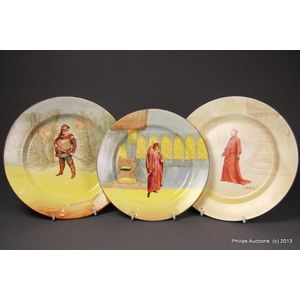Royal Doulton Shakespeare Series 'Ophelia' Plates (1911)
You must be a subscriber, and be logged in to view price and dealer details.
Subscribe Now to view actual auction price for this item
When you subscribe, you have the option of setting the currency in which to display prices to $Au, $US, $NZ or Stg.
- Bone China - Bone china, Also called 'English china", is one of the three types of porcelain, the other two being soft paste porcelain and hard paste porcelain.
Porcelain is an ancient ceramic material, first made in China, hence the common name "china", and the introduction of bone china was to counter the imports of Chinese porcelain.
The initial development of bone china is credited to Josiah Spode, who introduced it around 1800 and it was soon after copied by other manufacturers including Minton, Coalport, Davenport, Derby, Worcester, Wedgwood and Rockingham and the Herculaneum factory at Liverpool.
Spode's bone china was made by mixing ash from cattle bones with feldspar and kaolin, which created a material that was stronger, more translucent, and whiter than traditional porcelain. He began to produce this new type of porcelain in 1796 and it quickly became very popular.
At the time, the process and ingredients were kept secret and were only known to a few manufacturers and were protected by patents.
In the 19th century, bone china became increasingly popular and was widely produced by many manufacturers in England. During this time, it was considered a luxury item and was often used to create fine dining sets and other decorative items.
Bone china is still used in the production of fine porcelain wares, such as tea sets, figurines, and other decorative pieces. His basic formula of six parts bone ash, four parts china stone, and three and a half parts china clay remains the standard English body. It is still considered a luxury item due to its strength, translucency, and whiteness, and is often used for high-end and high-quality porcelain. China. - Polychrome - Made or finished in many colours. For furniture, it is used to indicated a painted finish.
- Earthenware - A basic ceramic material that is fired at a low temperature. Earthenware is the basis of almost all ancient, medieval, Middle Eastern and European painted ceramics. After firing, the colour is the colour of the clay when it is dug from the ground: buff, brown and red. It is not waterproof until glazed. Creamware is a type of earthenware covered with a transparent lead glaze. Majolica, faience and delft are also earthenware covered in an opaque white tin glaze.
This item has been included into following indexes:
Visually similar items

A fine Royal Worcester pin dish, by James Stinton, 1950, exquisite handpainted images of coloured pheasants amidst a misty setting by James (Jas) Stinton, signed, and upon a cream ground modulating to suffused burnished gold rims; with black backstamp unde

Royal Doulton Shakespeare series, 'Hamlet' plate and 'Wolsey' bowl, approx 19 cm and 20 cm deep ( 2)

A group of three Royal Doulton Shakespeare series plates. Various dates from 1923 (design dates earlier), plates of various sizes comprising 'Wolsey', D 3746 in a sepia toned church setting circa 1923-1927; 'Falstaff', number 3596 in a forest, from 1932; a

A pair of Royal Doulton cabinet plates, painted with fish, each within an etched gilt border. Diameter 22.5 cm.
